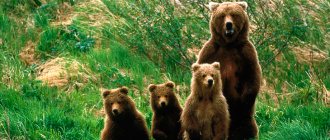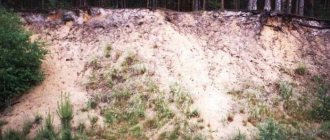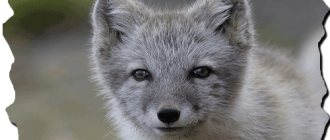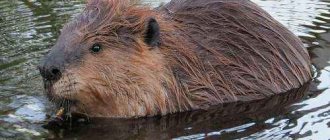Can hares swim? Can hares swim?
Can hares swim?
Can hares swim? Can a hare swim or will it immediately drown? Very interesting question! I would never have thought that hares would be able to swim on water if you hadn’t asked this question. I decided to find out - is this possible? After all, at school we learned how Grandfather Mazai saved hares in the spring, putting them on his boat, ferrying them from small islands, where they ended up due to the spring flood, to land. This means that hares can’t swim, they thought then.
But it turns out that this is not true at all! Hares can swim, and they do it very well. I was convinced of this by reading several interesting articles about them.
In fact, they don’t like to swim and try not to go into the water, but situations are different. Hares can freely swim across the river.
Hares can swim, but another thing is that you are unlikely to catch them splashing in the water with pleasure. They do not swim very well and cannot swim long distances. During the spring flood, they will sit on dry “islands” until the last moment and will only swim out of great need. They can escape fire by swimming in a river or lake. During a flood, even if hares swim across a river or lake, the water is so cold that they can die if they get wet. That’s why Grandfather Mazai saved them in Nekrasov’s famous work. The hare will not climb into the water again. They also wash off subcutaneous fat like cats.
Whether hares can swim or not, hares are not the first swimmers of all animals, according to Paustovsky. I remembered the story “Leaf Faller” about a little hare who swam out, thanks to a beaver, when an otter violated the integrity of the hut. The little hare learned to swim by clinging to a beaver.
The little hare was small and had not yet learned to swim.
In general, in the wild, many animals know how to swim; if you need to escape, get across the water and there is no other way than swimming. Some even do it with pleasure, if you believe the story of one expedition member who witnessed how two white hares crossed the strait, reaching an island, covering a distance of 300 m, which is located somewhere in the White Sea archipelago.
Hares can swim, but what can make them jump into the water and swim? Unless absolutely necessary, they will not climb into the water and get wet.
Is it possible to wash rabbits?
Bathing a decorative rabbit is not recommended for several main reasons:
- It is quite difficult to hold a pet correctly and securely, since he is simply not enthusiastic about such an event. As a result, you will have a lot of scratches, and the rabbit himself will be incredibly stressed.
- Hard water in combination with low-quality shampoos produces a terrible effect - its natural shine is removed from the coat. One wash will not affect the health of the fur coat, but regular bathing can easily cause baldness of your pet.
- The animal's fur is very thick and does not dry well. You will not be able to completely dry your pet; put it in a cage while still wet, which can provoke a life-threatening cold for the animal.
Many owners who wonder whether it is possible to bathe decorative rabbits receive a categorical “no” in response.
But still, unpleasant moments arise when you need to wash your pet:
- It happens that it gets dirty to such an extent that it is scary to look at it. You can shake off the shavings, but if he comes across something sticky while walking around the apartment, you need to use water.
- It is necessary to wash your fluffy when diarrhea occurs. A decorative rabbit is not allowed to lick itself, so the source of dirt must be removed from its body.
- Veterinarians recommend washing your pet if there is heatstroke.
If you still need to buy your decorative pet, it must be done correctly and carefully.
Do all inhabitants of the deep waters know how to swim?
It is believed that if an animal lives in water, then nature itself gives it the ability to swim. However, this is not quite true. For example, in the depths of the World Ocean there is a batfish. It, outwardly practically no different from other fish, moves along the bottom, using the pectoral fins as legs. Therefore, when asked which animals cannot swim, we can confidently answer that this is a bat.
But if someone claims that crayfish and lobsters cannot swim, they will be wrong. These arthropods can, in rare cases, swim using their tail. Although crustaceans still prefer to crawl.
Video
We recommend watching an interesting video about “swift-footed” and “eared” ones.
| Brown hare | |
| Scientific classification |
| Domain: | Eukaryotes |
| Kingdom: | Animals |
| Sub-kingdom: | Eumetazoans |
| Without rank: | Bilaterally symmetrical |
| Without rank: | Deuterostomes |
| Subtype: | Vertebrates |
| Infratype: | Ghostostomes |
| Superclass: | Quadrupeds |
| Class: | Mammals |
| Subclass: | Animals |
| Infraclass: | Placental |
| Superorder: | Euarchontoglires |
| Grand detachment: | Rodents |
| Squad: | Lagomorpha |
| Family: | Zaitsevy |
| View: | Brown hare |
Brown hare
(lat. Lepus europaeus) - a mammal of the genus of hares of the order Lagomorpha.
What kind of land bird swimmers are they?
This is where it’s quite difficult to answer. Almost all birds love to wallow in a puddle. But no one tried to make them swim. There are certain types of land birds that know how and love to swim, for example, the dipper from the passerine genus. But most birds cannot swim.
But the well-known domestic chicken, which, according to popular belief, is afraid of water, stays perfectly on its surface and even moves, although not as fast as geese or ducks.
Threw his SON from a big tower | How to get into diving?
Show description INSTAGRAM: https://www.instagram.com/babeshking/. I promised you a long time ago that I would throw someone from my family off the tower :) We shot this video in the pool some time ago. Mark likes diving, but no one thought that he would ask to go straight to a huge 5-meter tower. How will it end? In this video we will also look at what is needed for your child to be accepted into the diving sports section (not to be confused with swimming).. Timecodes: 00:00 – Intro. 00:51 – Greetings with Mark. 01:48 – Training: somersaults, cartwheel. 03:47 – Mark jumps from 1 meter. 04:15 – Workout: Leg raises, abs, rope. 05:20 – Mark jumps upside down and into a circle. 06:03 – Training: Stretching, long jump. 06:54 – Mark jumps from 3 meters. 07:44 – Training: Falling on your back. 08:57 – Mark jumps from 5 meters. PS Keep in mind, I've been diving for over 20 years, so I know exactly what's possible and what's not. Under no circumstances repeat it yourself.. ★ TOP VIDEO WITH VADIM'S GUESTS: https://www.youtube.com/watch?v=263nt1AOJNQ&list=PLVTCIV837F1zIvKwxTxDaKLWE6cyR6qrq. ★ BEST CHALLENGES IN THE POOL: https://www.youtube.com/watch?v=lRLAUWt8-gg&list=PLVTCIV837F1zWlHzXcsmpXOLfPpvaHf0J. For advertising: write to Direct: https://www.instagram.com/babeshking/ (response within a few hours), for urgent commercial requests: or. +7 Roman (Whatsapp only)
Video taken from channel: Vadim Babeshkin
Swimming camels? Nonsense!
There are probably more people who can swim than those who can’t. Although when asked which animals cannot swim, many today claim that these are camels and giraffes.
Some even come up with a fictitious theory that these animals' humps are filled with water, which will definitely pull them down. Therefore, a camel, turning over on its back, will not only be unable to swim, but also to stay on the water.
But these are all inventions of ignorant people. Camels are excellent swimmers, although in natural conditions in their historical homeland they practically cannot see the river. Eyewitnesses claim that even small camels swim beautifully. And these graceful “ships of the desert” do not turn over on their backs at all. And why would they do this? After all, in their humps it is not water, but fat, and, as you know, it is lighter than water.
Truths and myths about rabbits
Rabbits, like many other rodents, look very cute and act no less cute. But how much do we know about them? About their habits, about what is hidden from the eyes of an outside observer? Maybe these rodents have their own secrets? Don't even doubt it - they have secrets! We have selected 15 examples of the secrets of rabbits that only breeders know about and that are unlikely to be told about in a pet store...
What do animals eat in winter?
By following the tracks you can not only determine the location of a hare or a hare, but also find out how hares spend the winter. For example, it was noticed that at the very beginning of winter, when there is not yet much snow, both species live near fields with winter crops. It is here that they feed on young shoots of rye and wheat.
Hares have to change their habitat as snow cover increases. It is no longer possible to find enough food in the fields. The animals choose less snowy areas. The hare moves closer to the vegetable gardens, orchards, and dachas. Here animals, eating the bark of fruit trees, cause considerable damage to the plantings. Young seedlings especially suffer from the hare's teeth.
In the forest where the white hare winters there is enough food until spring. Animals feed on bark and branches of deciduous trees and shrubs, frozen berries, and dried grass. When mowing, they eat hay prepared for domestic animals, which also causes some harm.
Distribution[edit | edit code ]
The hare is a native steppe animal of Europe, Asia Minor and Asia Minor, and North Africa. Its expansion to the north probably began no earlier than the middle of the Quaternary period. Currently, it is widespread in the steppes, forest-steppes, tundras and sparsely forested areas of the forest zone of Europe, in the north to Ireland, Scotland, southern Sweden and Finland, in the south to Turkey, Transcaucasia, Iran, the northern Arabian Peninsula, North Africa, northern Kazakhstan. Fossil remains are known from Pleistocene deposits of Azerbaijan and Crimea.
Within Russia, it is found throughout the European part of the country to the northern coasts of lakes Ladoga and Onega, the Northern Dvina; further, the distribution border goes through Kirov, Perm, skirting the Ural Mountains, through Kurgan to the Pavlodar region of Kazakhstan. The southern border passes through Transcaucasia, the Caspian Sea, Ustyurt, the northern Aral Sea region to Karaganda. Acclimatized in a number of regions of Southern Siberia (foothill areas of Altai, Salair and Kuznetsk Alatau). It was produced in the Altai and Krasnoyarsk territories, in the Novosibirsk, Kemerovo, Irkutsk and Chita regions. Acclimatized in the Far East: released in the Khabarovsk Territory in 1963-1964 (Jewish Autonomous Region), in 1965 - in the Primorsky Territory (Ussuriysk and Mikhailovsky districts). In Buryatia, attempts at acclimatization were unsuccessful.
Artificially spread to North America. Thus, the hare was brought to the state of New York in 1893 and in 1912 to the province of Ontario (Canada). Now found mainly in the Great Lakes region. Also imported to Central and South America; was acclimatized in New Zealand and southern Australia, where it became a pest.











